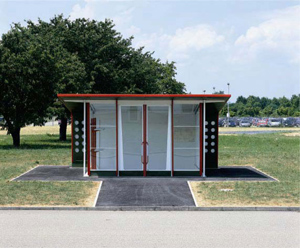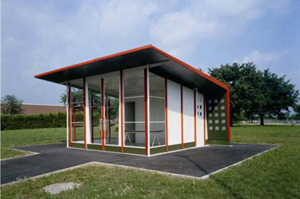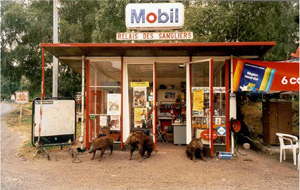 |
 |
 |
 |
 |
 |
| |
 |
|
 |
 |
 |
  |
  |
 |
 |
 |
 |
|
|
 |
|
 |
 |
 |
BUILDING |
 |
|
 |
|
 |
 |
 |
| |
 |
| 
 |
Petrol Station
|
|
 |
 |
 |
 |
DESIGNER |
 |
|
|
 |
|
 |
 |
 |
| |
 |
|
 |
 |
 |
 |
DESCRIPTION |
 |
|
|
 |
|
 |
 |
 |
|
|
 |
 Jean Prouvé (1901-1984), who was born in Paris and died in Nancy, is regarded as one of the most important and influential constructors of the twentieth century. The son of a protagonist of the "Ecole de Nancy," which was committed to the principles of Art Déco, Prouvé became trained as an artisan in metalwork. As early as 1923, he founded his first workshop in Nancy with a primary focus on interior architecture and furnishings. Efficient production methods, the industrial prefabrication of building elements and material- appropriate applications became the hallmarks of Prouvé's work. In concurrence with his consistent rejection of the primacy of formal dictates, his developmental path led from the artistic form of early years to the utilitarian form. His conceptual approach was that of a product designer with a purposeful aim, who spurned utopian designs and defined progress solely upon the basis of empirical verification. Consequently, Prouvé was much less concerned with architectural aesthetics than with the optimisation of a product as exemplified by the automobile and aircraft industries. An aeroplane would not fly if it were made like architecture, according to Prouvé's citation of a manager in the aircraft industry. Jean Prouvé (1901-1984), who was born in Paris and died in Nancy, is regarded as one of the most important and influential constructors of the twentieth century. The son of a protagonist of the "Ecole de Nancy," which was committed to the principles of Art Déco, Prouvé became trained as an artisan in metalwork. As early as 1923, he founded his first workshop in Nancy with a primary focus on interior architecture and furnishings. Efficient production methods, the industrial prefabrication of building elements and material- appropriate applications became the hallmarks of Prouvé's work. In concurrence with his consistent rejection of the primacy of formal dictates, his developmental path led from the artistic form of early years to the utilitarian form. His conceptual approach was that of a product designer with a purposeful aim, who spurned utopian designs and defined progress solely upon the basis of empirical verification. Consequently, Prouvé was much less concerned with architectural aesthetics than with the optimisation of a product as exemplified by the automobile and aircraft industries. An aeroplane would not fly if it were made like architecture, according to Prouvé's citation of a manager in the aircraft industry.
The Frenchman's interest was captured by both large and small scale projects – he saw no significant difference between the construction of a piece of furniture or that of a house. Prouvé's furniture designs set new standards just as his buildings did, the latter of which can be considered early manifestations of high-tech architecture by virtue of their series production elements.
The "Ateliers Jean Prouvé SA," initiated in Maxéville north of Nancy in 1944, with production beginning in 1947 and remaining under the direction of Prouvé until 1954, became an experimental laboratory with a periodic workforce of as many as 200 employees. Several of his most significant buildings and designs date from this time period, including the glass manufacturing school at Croismare (1948), the projects for tropical houses (1949), the exhibition pavilion for "Aluminium de France" and his own residence on an embankment above Nancy (both 1954).
 The standardisation of serially produced, prefabricated parts was one of the major aims of the Ateliers in Maxéville: A building must be comprised of the smallest possible number of different elements, according to Prouvé. The building technique with lightweight metal elements advocated by Prouvé was particular suited to construction tasks that required the transport of materials over long distances, rapid realisation and easy disassembly. This was the case for temporary emergency housing and habitations in foreign climates, for school pavilions and also for petrol stations. The standardisation of serially produced, prefabricated parts was one of the major aims of the Ateliers in Maxéville: A building must be comprised of the smallest possible number of different elements, according to Prouvé. The building technique with lightweight metal elements advocated by Prouvé was particular suited to construction tasks that required the transport of materials over long distances, rapid realisation and easy disassembly. This was the case for temporary emergency housing and habitations in foreign climates, for school pavilions and also for petrol stations.
At the beginning of the fifties, the petrol station was regarded as a building type particularly representative of the era. Individual mass mobility established itself as a major characteristic of the post-war period; urban and rural landscapes were reshaped by the attributes of a vehicular society. According to present research, Prouvé worked on at least 20 different petrol station projects between 1951 and 1954 for virtually all of the major oil companies represented in France at that time. Only a few of the designed prototypes were executed; as the most successful, the project for the company Socony- Vacuum/Mobiloil developed in 1951 by Prouvé in collaboration with his brother Henry was built six times, according to documents in Prouvé's estate. Of these, only three are extant today.
 One of the three remaining petrol stations, the "Relais des Sangliers"—originally located in the French département Haute- Loire—was recently acquired by Vitra and now stands on company grounds in Weil am Rhein near the main entrance. Constructed out of metal with lightweight building techniques, the petrol station guaranteed easy disassembly due to the series production of its individual elements, which are also found in other Prouvé buildings. Another aim of this small architectural work was a high recognition factor in the interest of unmistakable brand identity. Extending laterally on both sides, the roof shell sweeps over the small glazed sales area, with a small adjacent room toward the rear. The building consists of angular aluminium elements, sheet metal with circular perforations and prefabricated windows and doors. The load-bearing framework and wall structures are clearly distinguished, an approach typical of Prouvé that is emphasised here by the red, white and green painted surfaces of the various parts connected in the manner of a metal construction set. One of the three remaining petrol stations, the "Relais des Sangliers"—originally located in the French département Haute- Loire—was recently acquired by Vitra and now stands on company grounds in Weil am Rhein near the main entrance. Constructed out of metal with lightweight building techniques, the petrol station guaranteed easy disassembly due to the series production of its individual elements, which are also found in other Prouvé buildings. Another aim of this small architectural work was a high recognition factor in the interest of unmistakable brand identity. Extending laterally on both sides, the roof shell sweeps over the small glazed sales area, with a small adjacent room toward the rear. The building consists of angular aluminium elements, sheet metal with circular perforations and prefabricated windows and doors. The load-bearing framework and wall structures are clearly distinguished, an approach typical of Prouvé that is emphasised here by the red, white and green painted surfaces of the various parts connected in the manner of a metal construction set.
Among Prouvé's projects for petrol stations dating from the early fifties, the concept realised for Socony-Vacuum/Mobiloil was the smallest of his standardised designs; the larger projects encompassed a service station with a auto repair shop and a more extensive store area. Presumably none of these plans were executed.
Due to the fact that Prouvé developed concepts exemplified in his own lightweight constructions—which were largely considered unspectacular—but otherwise stood in the shadow of designing architects as an experimental engineer, his importance for the history of twentieth century architecture and design slipped into a long obscurity. Yet after the time in Maxéville, Prouvé was drawn into major construction projects as an engineer, including the monumental hall of the Centre Nationale des Industries Techniques CNIT (1959) in the Parisian office satellite city La Défense and the highly structured complex of institutes at the Free University in Berlin- Dahlem (1967-69).
Following Prouvé's death, a few collectors and connoisseurs gathered his furniture and building elements in their private collections. The actual "rediscovery" of this designer did not take place until the late nineties, when the pavilion developed by Prouvé in 1954 for the monopoly "Aluminium de France" (to mark the centenary of the introduction of aluminium) was reconstructed in 1999 at Villepint in the vicinity of Paris' Charles de Gaulle Airport. One year later, Massimiliano Fuksas presented temporary emergency housing designed by Prouvé in 1945 for war victims as a historical reference at the Architecture Biennial under the motto "Less aesthetics, more ethics." The French constructor's renaissance experienced its most recent climax on the occasion of exhibitions in Nancy and Paris commemorating his 100th birthday.
Important original objects by Jean Prouvé have been represented in the Vitra Design Museum Collection since the beginning of the 1980s. In the year 2000, Vitra established contact with Prouvé's heirs and subsequently acquired worldwide manufacturing rights to his designs. The most significant designs were selected for re-edition in 2002, including three chairs ("Cité armchair" 1930; "Standard" 1934; "Antony" 1954), the lamp "Potence" and five tables ("Guéridon" 1949/50; "Table EM" 1950; "Granito" 1950; "Trapèze" 1950-54; "Compas Table" 1950). The brochure presented in conjunction with the launch of the Vitra Prouvé Collection placed the Frenchman's oeuvre alongside the works of Charles and Ray Eames. In tandem with the Eameses, Prouvé thus assumes his rank as the second dominant constructor of the twentieth century.
Vitra's contribution to the dissemination of Jean Prouvé's ideas is now augmented by the presence of the petrol station on company grounds.
Edited by Vitra |
|
 |
 |
 |
 |
 |
 |
 |
MATERIALS |
 |
|
|
 |
|
 |
 |
 |
 |
 |
|
 |
 |
 |
 |
LOCATION |
 |
|
|
 |
|
 |
 |
 |

|
 |

|
Continent |
|
 |
|
Nation |
|
 |
|
Land |
|
 |
|
District |
|
 |
|
Town |
|
 |
|
Neighborhoods |
|
 |
|
Address |
|
 |
|
|
|
 |
|
 |
 |
 |
 |
MAP |
 |
|
|
 |
|
 |
 |
 |
| |
 |
|
 |
 |
 |
 |
|
TYPOLOGY |
 |
|
|
 |
|
 |
 |
 |
|
|
 |
ARCHITECTURE | Transport buildings and structures
Service stations, rest areas with facilities, motorway tollhouses
Operations on existing buildings
Completion, rebuilding
Other architectural structures
Pavilions, kiosks, facilities
| |
 |
 |
 |
 |
CHRONOLOGY |
 |
|
|
 |
|
 |
 |
 |
Project |
 |
|
 |
| 
 |
1953
|
|
Realisation |
 |
|
 |
| 
 |
2003 |
|
 |
 |
 |
 |
THE BUILDING IN CINEMA |
 |
|
|
 |
|
 |
 |
 |
| Title |
 |
|
 |
| Chair Times. Stühle in ihrer Zeit. 1800 bis heute [Chair Times. A History of Seating. From 1800 to Today]
|
|
| Directed by |
 |
|
 |
|
| Nationality |
 |
|
 |
|
| Year of production |
 |
|
 |
|
| Cast |
 |
|
 |
| Rolf Fehlbaum, Mateo Kries, Ronan Bouroullec, Christian Brändle, David Chipperfield, Antonio Citterio, Jochen Eisenbrand, Ulrich Fiedler, Hella Jongerius, Amelie Klein, Serge Mauduit, Peter Noever, Arthur Rüegg, Leonie Samland, Ruggero Tropeano |
|
| Building's role |
 |
|
 |
|
| Annotations |
 |
|
 |
|
 |
 |
 |
 |
 |
 |
 |
CLIENT |
 |
|
|
 |
|
 |
 |
 |
| |
 |
|
 |
 |
 |
 |
STAFF |
 |
|
|
 |
|
 |
 |
 |
Project  |
 |
|
|
 |
|
Associate designers  |
 |
|
 |
 |
 |
 |
RELATED PROJECTS |
 |
|
|
 |
|
 |
 |
 |
| |
 |
|
 |
  |
 |
|
|